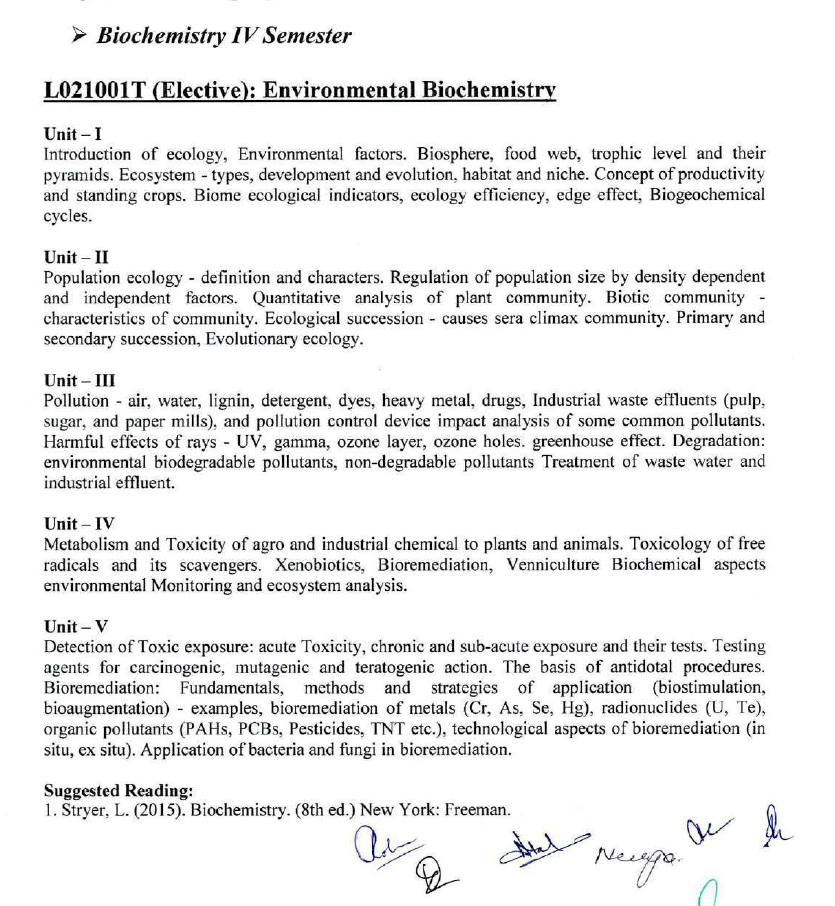This course is about Cell and Tissue Culture.
- Faculty: Anuradha Kalani

Environmental Biochemistry
Environmental biochemistry is an interdisciplinary field that explores the chemical and biochemical processes occurring in the environment and their effects on living organisms. It examines how pollutants, natural compounds, and biochemical cycles interact within ecosystems, influencing both biological and environmental health.
Key Areas of Environmental Biochemistry
Biogeochemical Cycles
Environmental biochemistry plays a crucial role in understanding biogeochemical cycles such as the carbon, nitrogen, sulfur, and phosphorus cycles. These cycles regulate essential elements in ecosystems and influence global climate patterns. For example, nitrogen fixation by bacteria converts atmospheric nitrogen into biologically usable forms, while carbon cycling affects greenhouse gas concentrations.Pollution and Biochemical Impacts
Human activities introduce pollutants such as heavy metals, pesticides, and plastics into ecosystems. These contaminants can disrupt biochemical pathways in organisms, leading to toxic effects. For example, heavy metals like lead and mercury interfere with enzyme function, causing neurological and developmental disorders in humans and animals.Enzymatic Bioremediation
Bioremediation utilizes microorganisms and enzymes to degrade or neutralize environmental pollutants. Microbes such as Pseudomonas and Bacillus species can break down hydrocarbons in oil spills, while certain fungi degrade plastic waste. Enzymatic detoxification processes, such as the action of peroxidases and oxidases, help in mitigating pollution.Oxidative Stress and Antioxidant Defense
Environmental stressors, including UV radiation, pollution, and toxins, can cause oxidative stress in living organisms by increasing the production of reactive oxygen species (ROS). To counteract this, cells produce antioxidants like glutathione, superoxide dismutase, and catalase, which help prevent cellular damage.Endocrine Disruptors and Biochemical Disruptions
Certain synthetic chemicals, such as bisphenol A (BPA) and phthalates, act as endocrine disruptors, interfering with hormonal balance in organisms. These compounds mimic natural hormones, leading to reproductive, developmental, and metabolic disorders in wildlife and humans.Climate Change and Biochemical Responses
Rising global temperatures and increasing carbon dioxide levels impact biochemical processes in plants, animals, and microbes. For example, ocean acidification, caused by excess CO₂ absorption, affects calcium carbonate formation in marine organisms, disrupting marine ecosystems.
Conclusion
Environmental biochemistry is vital for understanding and addressing ecological challenges. By studying biochemical interactions within ecosystems, scientists can develop strategies for pollution control, sustainable resource management, and climate change mitigation. As environmental issues grow, this field continues to play a crucial role in promoting a healthier planet.
- Teacher: Vishal Chand
The aim is to offer detailed knowledge about enzymes, which catalyze
the entire repertoire of biochemical reactions in life processes. It provides basic concepts of their mechanism of action, kinetics, regulation, inhibition,
purification, and diverse applications.
- Teacher: Neerja Srivastava

